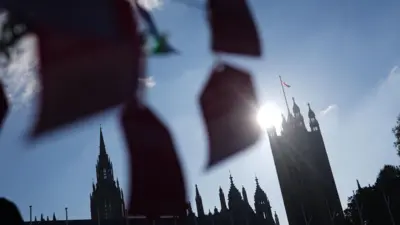We've updated our Privacy and Cookies Policy
We've made some important changes to our Privacy and Cookies Policy and we want you to know what this means for you and your data.
Welsh government's £48k wind turbine creates £5 of power a month
- Author, Paul Martin
- Role, ┤¾¤¾┤½├¢ News
Top Stories
A wind turbine that cost the Welsh government £48,000 to buy has been generating an average of just £5 worth of electricity per month.
The turbine was put its Aberystwyth office, rated excellent for sustainability, in 2009.
The Welsh government said the turbine had mechanical problems.
But before it was installed, the turbine makers warned Welsh government contractors it would not be exposed to enough wind where it was positioned.
The turbine's output has been monitored officially since January last year and figures suggest it could take hundreds of years for it to offset the cost of its purchase and installation.
Top Stories
The Welsh government confirmed in a response to a Freedom Of Information request that between January 2012 and July this year the turbine generated 585 kilowatt hours of energy (kWh) - an average of 33 kWh per month.
Taking 16p as an estimate for the current price of electricity per kWh in the consumer market, it works out at a value of £5.28 per month.
The Welsh government said there had been mechanical problems with the turbine and that throughout 2012 it was only operating at 26% of its capacity.
Some improvements have been made and as of January this year it has been operating at 68%.
But if it continues to operate at 68% capacity then it will generate 55.25 kWh per month - electricity with a value of £8.84.
At that rate it would take around 452 years to offset the cost of buying and installing the turbine.
The company which manufactured the turbine, Quiet Revolution, said mechanical problems were not the main reason for its performance but its location.
The company showed ┤¾¤¾┤½├¢ Wales a letter written before the turbine was installed which made it clear it was sceptical the location would expose the turbine to enough wind to make it viable.
Right location
Top Stories
That letter was sent to a company called Mitie which was acting as the contractor to the Welsh government.
Neither Mitie nor the Welsh government have been able to confirm yet whether Quiet Revolution's advice was taken into account when the turbine was given the go-ahead.
It is not uncommon for an organisation to use a small wind turbine as a means of generating some of its own electricity.
Paul Burrell from Anemos, a company based in Machynlleth, Powys, which installs small and medium-sized wind turbines, said in the right location turbines like this could be very effective.
"I think the problem is quite simple - it's been put in the wrong place," he said.
"It's very important with any wind turbine to ensure it's in the most exposed location possible. They need unobstructed access to wind from all directions.
'Very patchy'
"Unfortunately the Welsh government's one is located in a valley, two miles from the sea and has quite a short tower.
"It's located next to tall buildings so even if there's a strong wind it will be displaced by the time it reaches the turbine, it will be very patchy and lacking in potential so the turbine won't get the chance to spin properly."
He said using a wind turbine was a sound economic investment as long as it was in the right location.
"The payback period (on initial capital investment) can be anywhere between four and seven years," he added. "There are many examples of turbines across Wales on track to do this.
"A turbine this size should produce around 9,000 kWh per year which is a significant amount of power."
A Welsh government spokesperson said: "We have an ambitious carbon management strategy for the whole of our estate which includes a wide range of activities aimed at reducing CO2 emissions.
"For example, the Welsh government office in Aberystwyth includes a biomass heating system, solar panels and a wind turbine designed to power a small number of workstations.
"As a result we have seen a 17% reduction in CO2 emissions over the past two years and are well on course to meet the overarching target of a 30% reduction by 2020."
Top Stories
More to explore
Most read
Content is not available








